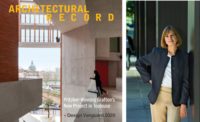Last month, nearly 500 architects and design enthusiasts, from across five continents, came together in Mumbai, India, for the Women in Design 2020+ International Conference. I was fortunate to be among them. Over the course of three days, three dozen speakers—including the architects Annabelle Selldorf, Billie Tsien, and Meejin Yoon from the United States—presented their work and shared experiences and insights about design, community, culture, history, and much more. Besides architects and urbanists, we heard from artists, and even a filmmaker, Vibha Bakshi, whose award-winning documentary Son Rise, about misogyny and the quest for justice for rape in patriarchal rural India, moved many in the audience to tears.
The conference, organized by the Mumbai architect Brinda Somaya, was the sequel to the first Women in Design event she initiated, in 2000. “Much has changed,” she said in her opening remarks, “but much has not.”
Gender, of course, was central to the conference. Said Shimul Javeri Kadri, who heads her own firm in Mumbai, “I was not a feminist. Architecture made me one.”
Yet the primary subject of interest was the work itself—not just the varied types presented, but the fact that much of it involved conservation and renovation. Somaya provided a key example of the breadth of practice. While her firm, Somaya & Kalappa Consultants, has designed handsome new buildings for such clients as tech companies and institutions, she has also led a number of significant restoration projects, from renovating Louis Kahn’s Indian Institute for Management in Ahmedabad (so far, the upgrade of the library has been completed) to the rebuilding of a Gujarat village after the 2001 earthquake.
Underpinning such restoration efforts are the designers’ engagement with communities and their strong respect for local conditions and materials. Salma Samar Damluji, a Beirut-based architect, showed her powerful projects rebuilding vernacular housing and mosques in bombed-out villages in Yemen, using traditional sun-baked mud brick. “It is their heritage, identity, and integrity,” she said of the local residents and craftsmen. Iranian-born architect Yasaman Esmaili, who is based in Boston and Tehran, presented her work with Mariam Kamara on the Hikma complex in Niger, which called for restoring and converting a crumbling mosque into a library and community center, and building a new mosque next to it out of the same beautiful, reddish compressed earth block.
Some architects talked about their involvement in restoring indigenous infrastructure such as the famous Indian stepwells; others about defending the modest, unscripted streetscapes—the jumble of shops, small manufacturing and housing—that make up so much of Asia’s vibrant urban culture. Collectively, the presentations underscored the value of tradition and heritage as well as the designers’ profound belief that the conservation or repurposing of existing building stock is the bedrock for making cities sustainable.
It is a lesson that hasn’t taken firm root in most of the world, as soaring land values in major metropolises encourage developers to tear down and build bigger, despite the waste produced by demolition and the cost in carbon emissions from all aspects of new construction—from extraction to manufacture to transportation of building components to the site. Despite the real-estate profits to be made today, the bill to the planet will come due, sooner rather than later.
In this issue of Architectural Record, we celebrate a varied collection of restored, renovated, and repurposed structures, from a 1930s aluminum factory complex in Northern Italy, now transformed into a tech hub to a tough 1965 concrete library in Nashville converted to offices and the rethinking of Eero Saarinen’s immense Bell Labs in New Jersey as a “metroburb”—a “downtown” in the suburbs—with shops, dining, and offices all under one gigantic roof.
These gestures toward recycling buildings rather than destroying them may seem minor, but they are part of what should be a growing shift in attitude—a way of embracing the past to protect the future. At the Mumbai conference, Somaya took a moment to quote Gandhi: “In a gentle way, you can shake the world.”







Post a comment to this article
Report Abusive Comment